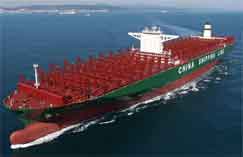More tough times for container ship carriers, both right now and likely for four to six more years.
In the current market, rates remain at levels bringing carriers to their knees, most recently with dramatically falling rates for container shipments from Europe to East Coast US ports.
Supply Chain Digest Says... |
 |
|
| Using what they admit are “rather optimistic assumptions,” Sea-Intelligence says oversupply peaking will peak at about 14% in 2024 and taking years to fall back towards an in-balance situation. |
|
 |
|
What do you say? |
|
| Click here to send us your comments |
|
| |
|
| Click here to see reader feedback |
|
|
|
According to a report on TheLoadstar.com web site, leading container carrier CMA CGM, says rates for this westbound transatlantic container traffic have now hit “unsustainable levels.”
The French carrier said this in parallel with the announcement a of FAK (freight all kinds) rate increases last week, desperately hoping to drive rates back up on Europe to East Coast routes that have become as one carrier executive described to The Loadstar as “a total disaster.”
The data supports such anecdotal reports. Maritime data firm Xeneta’s index of rates for shipping a 40-foot container from North Europe to the US East Coast fell from $7,700 a year ago to just $1,327 last week.
In fact, The Loadstar recently saw an offer to a UK-based forwarder that was below $1,000 to ship 40-foot containers for relatively small-volume shipments from Liverpool to New York.
CMA CGM has set its base rate to ship a 40-foot container on the popular Rotterdam to the Port of New York at $1600, well below the rates in the pre-pandemic year of 2019 and in the first couple years of pandemic shipping, when rates soared.
Most Europe to US lanes have recently been considered fairly stable.
“We never expected to make much money out of the transatlantic, but we certainly didn’t expect to lose our shirts on it,” a carrier source told The Loadstar.
There has been a large increase in capacity on transatlantic lanes, which inevitably resulted in over-supply and a dramatic fall in container freight rates to levels well below their historical average.
According to Alphaliner, the capacity growth on the transatlantic was led by China’s Cosco, including its OOCL subsidiary, with a huge year-on-year expansion of 38.1%, followed by CMA CGM with capacity growth of 34.2%.
With things looking bleak for carriers but good for shippers, when can container lines expect to get out of this excess capacity situation?
Not any time soon, according a new report by the Danish analysts at research firm Sea-Intelligence.
(See More Below)
|
CATEGORY SPONSOR: SOFTEON |
|
|
|
|
|
 “The market is heading into a traditional down cycle, as 2023 is seeing significant excess capacity being delivered, and in all likelihood, the same will happen in 2024,” “The market is heading into a traditional down cycle, as 2023 is seeing significant excess capacity being delivered, and in all likelihood, the same will happen in 2024,”
Alan Murphy, CEO of Sea-Intelligence, said in the report.
According to a report on the Maritime Executive web site, Sea-Intelligence estimates that even after the large-scale ship deliveries that occurred this year, a surge of capacity growth is still on the way.
For example, MSC has received delivery of a large portion of its mammoth 24,000-plus TEU ships, the largest in the industry, while others including OOCL, ONE, and Hapag-Lloyd have also begun to receive their new ultra large container vessels.
Using what they admit are “rather optimistic assumptions,” Sea-Intelligence says oversupply peaking will peak at about 14% in 2024 and taking years to fall back towards an in-balance situation.
The report says the market could get back in balance by 2028, but there could be over supply through 2030.
“Gaining this balance in 2028 would imply an 8-year span – the same as the cycle from the financial crisis until balance was restored again in 2017,” Sea-Intelligence. observes.
What are your thoughts on this the container shipping market? Let us know your thoughts at the Feedback section below.
Your Comments/Feedback
|

